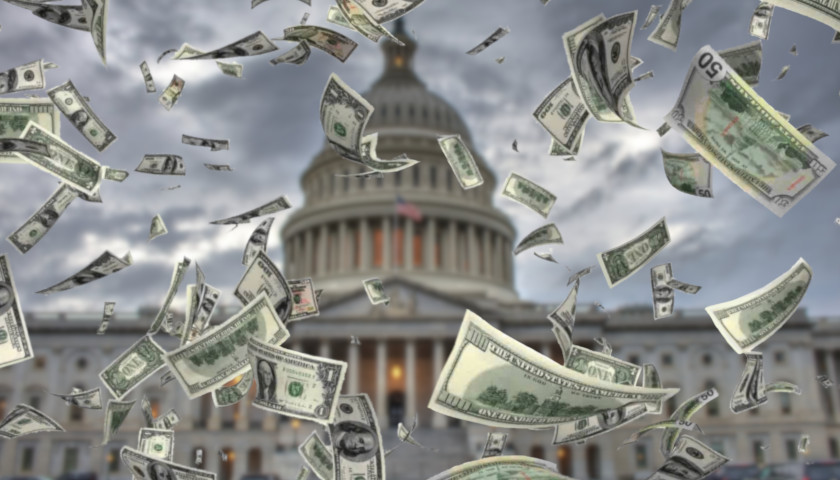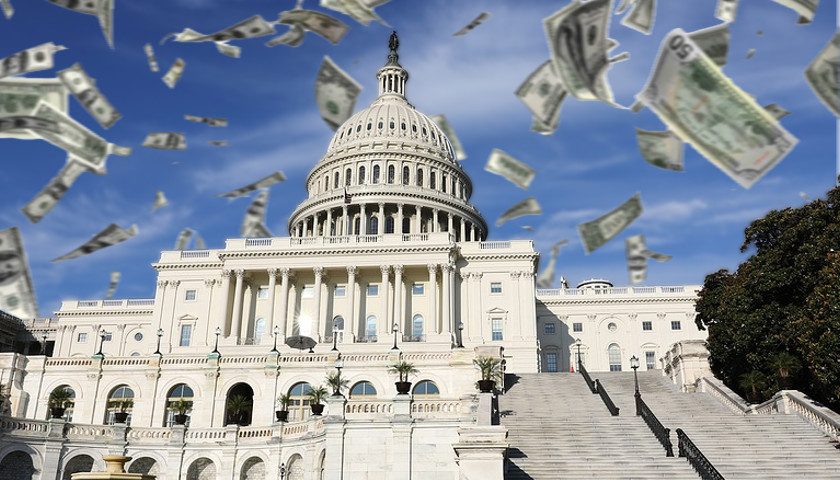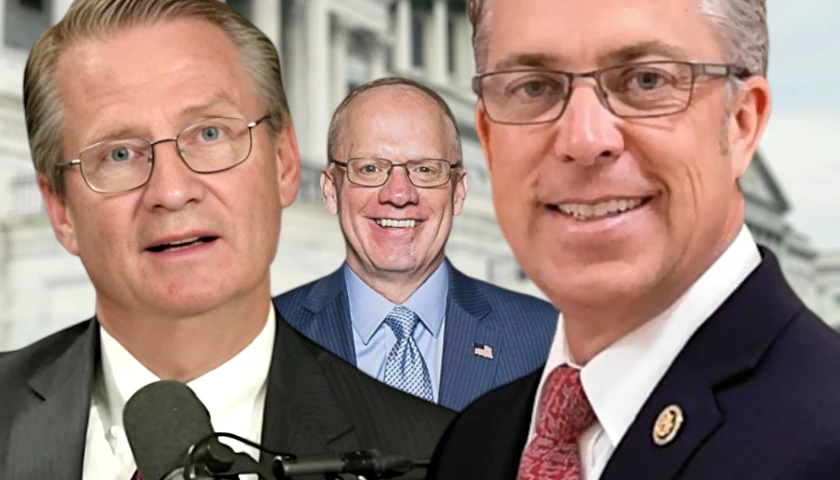by Robert Romano
With just two months remaining in fiscal year 2019, come Sept. 30, the U.S. budget deficit appears likely to come in just shy of $1 trillion, the latest data from the U.S. Treasury shows.
From October through July, the deficit has already come in at $866.8 billion. The U.S. budget deficit has not topped $1 trillion since 2012.
To get to $1 trillion for the year, the government would need a net deficit of a little more than $133 billion, but it has averaged only $44.7 billion in the months of August and September the past three years. It could still happen, but usually the federal government runs a surplus in September as the government tends to receive substantial corporate and income tax payments that month.
Even then, a budget deficit of $900 billion or so is nothing to sneeze at.
In fact, the national debt, now more than $22.3 trillion (a quarter of that is held by government trust funds), grew by almost $1.5 trillion in 2018 as spending in Washington, D.C. continues to outpace the growth of the economy and revenues.
Since 1980, the debt has grown on average 8.8 percent every fiscal year, but during that same period, the U.S. economy has only averaged 5.4 percent nominal growth before adjusting for inflation.
As a result, the debt is now 105 percent of the economy. And if those trends were to continue, the debt will top $100 trillion in 2037, and exceed 193 percent debt to GDP.
Even if the debt only grew by 7 percent, as it did last year, that still would grow the debt to more than $78 trillion by 2037.
What does that look like? Just ask Japan, whose economy has barely grown nominally in 20 years amid a declining population. It has a $10.5 trillion debt and just a $5.2 trillion Gross Domestic Product, a more than 200 percent debt to GDP ratio.
These jaw-dropping numbers should be enough to give any member of Congress pause as they consider votes on this year’s appropriations bill. Even so, many will doubt that the numbers matters that much. So, who’s right?
The question is whether these debt loads are sustainable or not over the long term. Will the dollar still be the world’s reserve currency by then? Will the dollar remain strong relative to other currencies? Will there still be such demand for U.S. treasuries on global financial markets? Will we still be running $870 billion-plus trade deficits annually? Will we experience another baby boom?
Perhaps the most critical factor to consider — since it captures the outcome of these other questions—is whether the economy will really grow at 5.4 percent nominally, a number which definitely relies on the booms of the 1980s and 1990s. Since 2000, nominally — that is, before adjusting for inflation — the economy has only averaged about 4 percent growth.
Meaning, there are scenarios where spending — much of which is baked into the cake of Social Security, Medicare, Medicaid, etc. — continues to increase substantially but the economy does not robustly grow at all, ala Japan. I certainly can foresee and worry about those scenarios.
On the other hand, there are other scenarios where one can forecast major economic growth, for example, if major production is restored to the U.S. from overseas, we do get a baby boom, trade deficits are reduced and more money is invested in building this country. In terms of bringing overseas production back to the U.S., that is certainly a major part of the economic vision President Donald Trump laid out for the American people in 2016.
With robust economic growth, then it’s a future where you also see substantial increases in revenue because you’re dealing with a larger pie, and so balancing the budget does not seem so insurmountable.
The bright side is nothing is set in stone yet, but almost all of the solutions I can conceive of all involve restoring strong growth to the U.S. economy. Revenues are rising compared to last year, $2.86 trillion from October to July, compared to $2.77 trillion at the same point last year. The trouble is spending is increasing much, much faster, with $3.73 trillion through the first 10 months of the fiscal year, compared with $3.45 trillion last year.
In terms of spending cuts, the sad truth is there is almost no will in Washington, D.C. to pare back the budget. The budget President Donald Trump and the Office of Management and Budget proposed would cut overall spending by $2.7 trillion over 10 years and bring the budget towards balance within 15 years. Unfortunately, Congress has not adopted many of the proposals in that budget.
When we did get budget sequestration in 2011 after the debt ceiling standoff between former President Barack Obama and Congressional Republicans, it essentially froze domestic, discretionary spending for a few years, and the deficit was reduced. So-called mandatory spending was never addressed because nobody wants to propose either cutting Social Security and Medicare benefits or raising payroll taxes. Even with sequestration, the lowest the deficit got was $441 billion in 2015. That’s still really, really large.
Here we are in 2019, at full employment, the economy’s doing okay, and all Congress had to do was take its foot slightly off the brakes and suddenly we’re nearly going to hit $1 trillion on the deficit. By the end of fiscal year 2020, we may very well cross that threshold again.
What do we suppose will happen the next time we have another recession? What if it’s a big recession like in 2008 and 2009? Then, deficits likely will become much, much greater as revenues take a hit.
Again, nothing is set in stone. I tend to think optimistically about the future because I do not think running perpetual trade deficits like we have was ever going to be sustainable. If the American people hadn’t voted for Donald Trump in 2016, they would have had to invent him. Eventually, policymakers were going to figure out that we could grow the economy here and we’d all be better off for it, revenues would grow and nobody would worry about the debt. It may be that Trump, whether he wins or loses his reelection bid in 2020, has already set us on that path. I certainly hope so.
– – –
Robert Romano is the Vice President of Public Policy at Americans for Limited Government.





